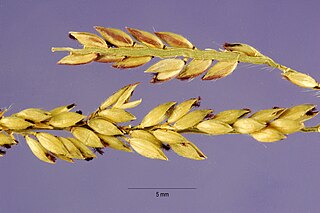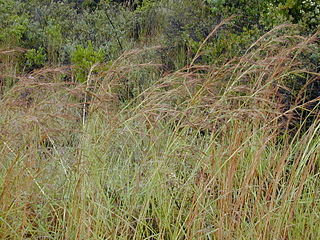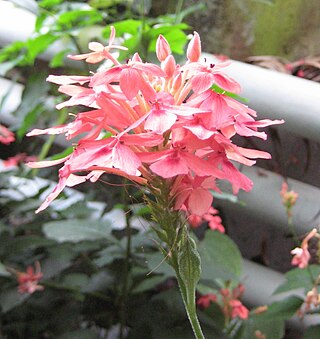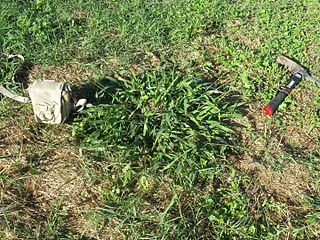| Sacciolepis | |
|---|---|
 | |
| Sacciolepis indica | |
| Scientific classification | |
| Kingdom: | Plantae |
| Clade: | Tracheophytes |
| Clade: | Angiosperms |
| Clade: | Monocots |
| Clade: | Commelinids |
| Order: | Poales |
| Family: | Poaceae |
| Subfamily: | Panicoideae |
| Supertribe: | Panicodae |
| Tribe: | Paniceae |
| Genus: | Sacciolepis Nash |
| Type species | |
| Sacciolepis gibba (syn of S. striata) [1] (Elliott) Nash | |
| Synonyms [1] | |
| |
Sacciolepis is a genus of plants in the grass family. [2] [3] Cupscale grass is a common name for plants in this genus. [4]
They are widespread in tropical and warmer temperate regions. Many are native to Africa, with others in Asia, Australia, and the Americas. [5] [6] [7] [8] [9] [10]
These species are annual or perennial and may have rhizomes or stolons. The inflorescence is usually a narrow, dense panicle. They generally grow in moist habitat, such as marshes and streambanks. [7] Sacciolepis is closely related to genus Panicum . [5] [6]
- Species [1] [11] [12] [13]
- Sacciolepis africana - Africa from Senegal to KwaZulu-Natal, Madagascar
- Sacciolepis angustissima - from the Guianas to Bolivia + Peru
- Sacciolepis antsirabensis - Madagascar
- Sacciolepis arenaria - Angola
- Sacciolepis catumbensis - Angola, Zambia
- Sacciolepis chevalieri - Africa from Senegal to KwaZulu-Natal, Madagascar
- Sacciolepis ciliocincta - Africa from Senegal to Sudan + Congo Rep
- Sacciolepis cingularis - Sudan, Chad, Congo Rep
- Sacciolepis clatrata - Central African Rep
- Sacciolepis curvata - eastern + southeastern Africa from Kenya to KwaZulu-Natal; Madagascar, Comoros, Seychelles, Tamil Nadu, Sri Lanka
- Sacciolepis cymbiandra - West Africa from Senegal to Nigeria
- Sacciolepis fenestrata - Thailand
- Sacciolepis indica - glenwood grass, Chase's glenwood grass, Indian cupscale grass - Africa from Guinea to Cape Province; Madagascar, Comoros, Mauritius, Réunion, Indian Subcontinent, East + Southeast Asia, Australia; naturalized in New Zealand, southeastern USA, scattered places in Latin America and Pacific
- Sacciolepis interrupta - tropical Asia, tropical Africa
- Sacciolepis leptorachis - tropical Africa
- Sacciolepis micrococca - tropical Africa, Madagascar
- Sacciolepis myosuroides - tropical Africa, Madagascar, tropical Asia, Australia
- Sacciolepis myuros - tropical America from central Mexico to Trinidad + Bolivia
- Sacciolepis otachyrioides - Colombia (Meta), Venezuela (Amazonas, Apure, Guárico), Guyana (Rupununi), Bolivia (Beni, Santa Cruz), Brazil (Amazonas, Roraima)
- Sacciolepis seslerioides - Congo Rep, Zaire, Tanzania, Zambia, Angola
- Sacciolepis striata - southeastern USA from Texas to Delaware; [14] Greater Antilles, Mexico (Veracruz, Tabasco), Central America, Trinidad, Venezuela, Guianas, Amapá
- Sacciolepis tenuissima - Thailand
- Sacciolepis transbarbata - Tanzania, Burundi, Zaire, Zambia, Angola, Malawi, Zimbabwe
- Sacciolepis typhura - Africa from Ivory Coast to Eswatini
- Sacciolepis viguieri - Madagascar
- Sacciolepis vilvoides - Cuba, South America from Venezuela to Uruguay
- formerly included [1]
see Hymenachne Panicum
- Sacciolepis aurita - Panicum auritum
- Sacciolepis donacifolia - Hymenachne donacifolia
- Sacciolepis insulicola - Panicum auritum
- Sacciolepis longissima - Panicum longissimum
- Sacciolepis polymorpha - Panicum auritum
- Sacciolepis semienensis - Panicum hymeniochilum















